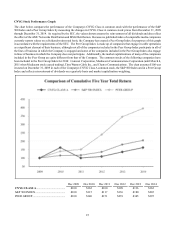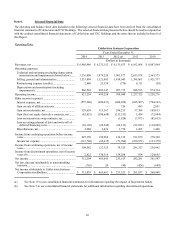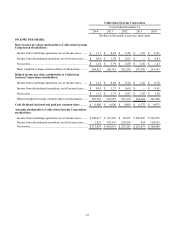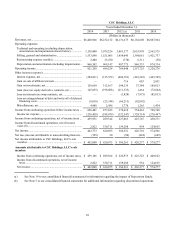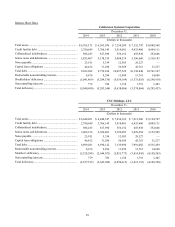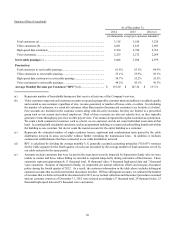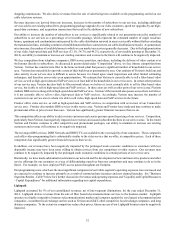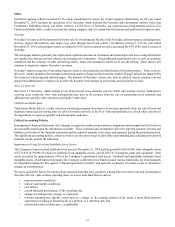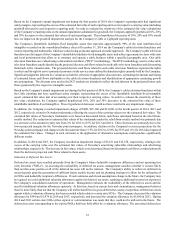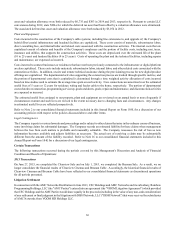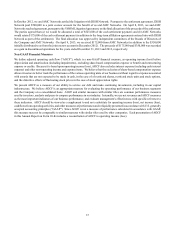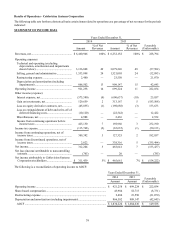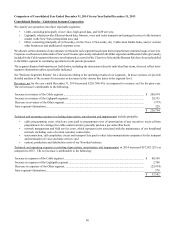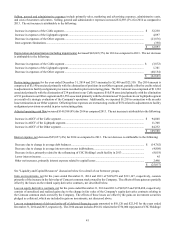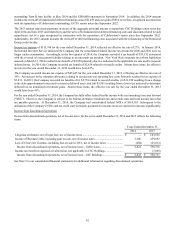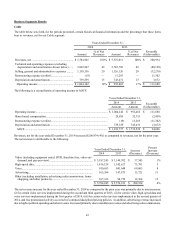Cablevision 2014 Annual Report Download - page 41
Download and view the complete annual report
Please find page 41 of the 2014 Cablevision annual report below. You can navigate through the pages in the report by either clicking on the pages listed below, or by using the keyword search tool below to find specific information within the annual report.35
Based on the Company's annual impairment test during the first quarter of 2014, the Company's reporting units had significant
safety margins, representing the excess of the estimated fair value of each reporting unit less its respective carrying value (including
goodwill allocated to each respective reporting unit). In order to evaluate the sensitivity of the estimated fair value calculations
of the Company's reporting units on the annual impairment calculation for goodwill, the Company applied hypothetical 10%, 20%
and 30% decreases to the estimated fair values of each reporting unit. These hypothetical decreases of 10%, 20% and 30% would
have no impact on the goodwill impairment analysis for the Company's Cable or Lightpath reporting units.
The Company's identifiable indefinite-lived intangible assets that represent approximately 99% of the total indefinite-lived
intangibles recorded on the consolidated balance sheet at December 31, 2014 are the Company's cable television franchises and
various reporting unit trademarks, which are valued using an income approach or market approach. The Company's cable television
franchises are the largest of the Company's identifiable indefinite-lived intangible assets and reflect agreements we have with state
and local governments that allow us to construct and operate a cable business within a specified geographic area. Our cable
television franchises are valued using a discounted cash flows ("DCF") methodology. The DCF methodology used to value cable
television franchises entails identifying the projected discrete cash flows related to such cable television franchises and discounting
them back to the valuation date. The projected discrete cash flows related to such cable television franchises represent the rights
to solicit and the right to service potential customers in the service areas defined by franchise rights currently held by the Company.
Significant judgments inherent in a valuation include the selection of appropriate discount rates, estimating the amount and timing
of estimated future cash flows attributable to the cable television franchises and identification of appropriate continuing growth
rate assumptions. The discount rates used in the DCF analysis are intended to reflect the risk inherent in the projected future cash
flows generated by the respective intangible assets.
Based on the Company's annual impairment test during the first quarter of 2014, the Company's cable television franchises within
the Cable reporting unit have significant safety margins, representing the excess of the identifiable indefinite-lived intangible
assets' estimated fair value unit of accounting over their respective carrying values. In order to evaluate the sensitivity of these
fair value calculations, the Company applied hypothetical 10%, 20% and 30% decreases to the estimated fair value of these
identifiable indefinite-lived intangibles. These hypothetical decreases would not have resulted in any impairment charges.
In addition, the Company recorded impairment charges of $200, $25,100 and $13,000, in the fourth quarter of 2014, 2013 and
2012, respectively, related to Newsday trademarks, reflecting the excess of the carrying values over the estimated fair values. The
estimated fair values of Newsday's trademarks were based on discounted future cash flows calculated based on the relief-from-
royalty method. The reduction in estimated fair values of the trademarks under the relief-from-royalty method was primarily due
to a decrease in the assumed royalty rate from 2% for 2012 to 0.5% for 2013 and 2014. These decreases are primarily due to the
lower projected margins for the Newsday print newspaper. In addition, declines in the Company's revenue projections for the
Newsday print newspaper and changes in the discount rate from 11.5% for 2012 to 12.0% for 2013 and 11% for 2014 also impacted
the estimated fair values. Changes in such estimates or the application of alternative assumptions could produce significantly
different results.
In addition, in 2014 and 2013, the Company recorded an impairment charge of $5,631 and $12,358, respectively, relating to the
excess of the carrying value over the estimated fair values of Newsday's amortizing subscriber relationships and advertising
relationships, respectively. The decrease in fair values, which were determined based on discounted cash flows, resulted primarily
from the decline in projected cash flows related to these assets.
Valuation of Deferred Tax Assets:
Deferred tax assets have resulted primarily from the Company's future deductible temporary differences and net operating loss
carry forwards ("NOLs"). In assessing the realizability of deferred tax assets, management considers whether it is more likely
than not that some portion or all of the deferred tax asset will not be realized. The Company's ability to realize its deferred tax
assets depends upon the generation of sufficient future taxable income and tax planning strategies to allow for the utilization of
its NOLs and deductible temporary differences. If such estimates and related assumptions change in the future, the Company may
be required to record additional valuation allowances against its deferred tax assets, resulting in additional income tax expense in
the Company's consolidated statement of operations. Management evaluates the realizability of the deferred tax assets and the
need for additional valuation allowances quarterly. At this time, based on current facts and circumstances, management believes
that it is more likely than not that the Company will realize benefit for its gross deferred tax assets, except those deferred tax assets
against which a valuation allowance has been recorded which relate to certain state NOLs. The Company decreased the valuation
allowance by $344 and $1,974 in 2014 and 2013, respectively, and increased the valuation allowance by $5,480 in 2012. During
2014 and 2013 certain state NOLs either expired or a determination was made that they could not be utilized in the future. The
deferred tax asset corresponding to the expired NOLs had been fully offset by a valuation allowance. The associated deferred tax


